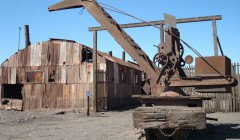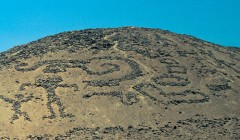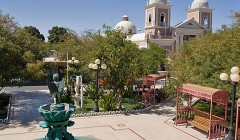- Geoglyphs
- Pica
Travel Type: Culture
Duration 1 Day
- Tour Description
First stop is a visit to the abandoned nitrate mining towns of Santa Laura and Humberstone that are witness to the days of the nitrate boom. During its heyday, Santa Laura had slightly more than 400 inhabitants, while Humberstone was home to 3,500 workers. Once upon a time, a hotel with a giant swimming pool, numerous warehouses, a church, a school, and a sports stadium brought life to the desert. Actors from all over the world performed in the theatre here. It all made for a bizarre atmosphere that can still be felt wandering the abandoned streets. The nitrate boom collapsed after the invention of synthetic ammonia, and the two mining towns were abandoned by their workers, though they were not officially closed until 1960/61. Both ghost towns were designated national monuments in 1970 and, since 2005, they are also listed on the UNESCO World Heritage List.
After your visit to Humberstone and Santa Laura, the tour traverses a large section of the Pampa del Tamarugal Nature Reserve – a large forest of around 240,000 ha in the middle of the desert – before reaching the ‘Pintados’ (painted) glyphs. The unique tamarugo trees in the park can grow up to 20m/66ft high, and are able to adapt particularly well to the salty ground, with a root system reaching to a depth of 12m/39ft.
The Pintados glyphs are pre-Columbian rock art that was made, either by scraping stone, or by laying dark stones over lighter layers. These giant stone mosaics can take up entire hillsides, and show representations of humans, animals and symbols. The origin of these works remains a mystery to this day.
The final destination of this day trip is the Pica Oasis, where the indigenous Indians of the village of Pica cultivate citrus fruit. Another feature here is a natural rock pool filled with clear spring water, which provides a wonderful spot for relaxation. Pica also boasts Chile’s oldest wine cellar that was built by Catholic missionaries. The church of Pica (1887) is also unique, as it was entirely constructed from natural borax blocks. Return to Iquique. Lunchbox included.
After your visit to Humberstone and Santa Laura, the tour traverses a large section of the Pampa del Tamarugal Nature Reserve – a large forest of around 240,000 ha in the middle of the desert – before reaching the ‘Pintados’ (painted) glyphs. The unique tamarugo trees in the park can grow up to 20m/66ft high, and are able to adapt particularly well to the salty ground, with a root system reaching to a depth of 12m/39ft.
The Pintados glyphs are pre-Columbian rock art that was made, either by scraping stone, or by laying dark stones over lighter layers. These giant stone mosaics can take up entire hillsides, and show representations of humans, animals and symbols. The origin of these works remains a mystery to this day.
The final destination of this day trip is the Pica Oasis, where the indigenous Indians of the village of Pica cultivate citrus fruit. Another feature here is a natural rock pool filled with clear spring water, which provides a wonderful spot for relaxation. Pica also boasts Chile’s oldest wine cellar that was built by Catholic missionaries. The church of Pica (1887) is also unique, as it was entirely constructed from natural borax blocks. Return to Iquique. Lunchbox included.





